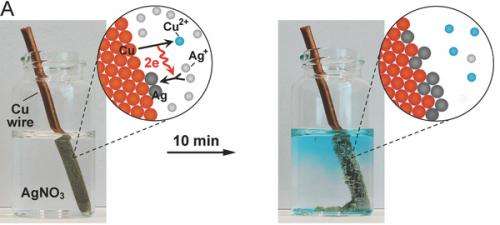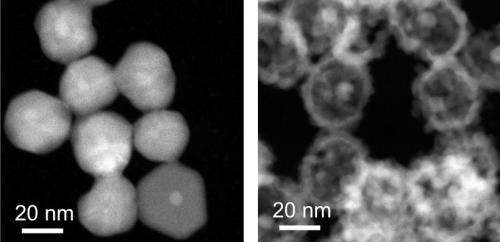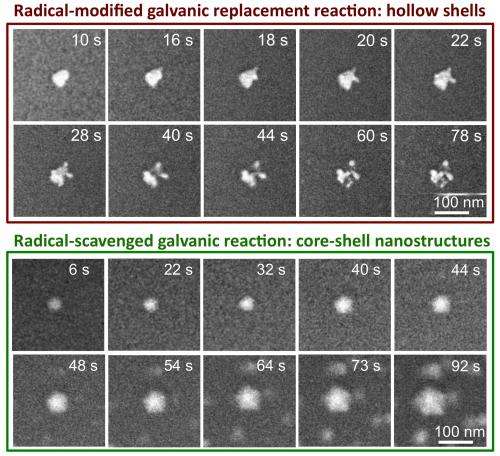Transforming the composition of nanoparticles using electrochemistry

Galvanic replacement reactions provide an elegant way of transforming solid nanoparticles into complex hollow morphologies. Conventionally, galvanic replacement is studied by stopping the reaction at different stages and characterizing the products ex situ. In situ observations by liquid-cell electron microscopy can provide insight into mechanisms, rates and possible modifications of galvanic replacement reactions in the native solution environment.
Researchers at Brookhaven National Laboratory used liquid-cell electron microscopy to investigate galvanic replacement reactions between silver nanoparticle templates and aqueous palladium salt solutions. Their in-situ observations follow the transformation of the silver nanoparticles into hollow silver–palladium nanostructures. While the silver–palladium nanocages have morphologies similar to those obtained in ex-situ control experiments the reaction rates are much higher, indicating that the electron beam strongly affects the galvanic-type process in the liquid-cell. By using scavengers added to the aqueous solution, researchers identified the role of radicals generated via radiolysis by high-energy electrons in modifying galvanic reactions.
Understanding how to control galvanic replacement reactions in nanoparticles is important for exploiting these materials in applications, such as nanoscale containers for diagnostics and drug delivery, contrast enhancement agents in biomedical imaging, or platforms for facilitating chemical reactions.
CFN Capabilities: CFN's Electron Microscopy facility provided an environmental transmission electron microscope with a special holder that can accept the liquid cell.
-

B: Electron microscopy images of the galvanic replacement reaction, transforming a silver nanoparticle into a hollow silver/palladium nanostructure. -

Top: Sequence of STEM images that follow the real-time evolution of a silver nanoparticle into a hollow silver/palladium structure wile in a palladium-based solution. Bottom: Sequence of STEM images that follow the real-time evolution of a silver nanoparticle into a hollow silver/palladium structure wile in a palladium-based solution with added isopropanol. In this case, the silver particle does not become entirely hollowed out. In fact, the reaction shifts toward growth, and a Ag core-Pd shell nanostructure is formed.
More information: "In situ liquid-cell electron microscopy of silver–palladium galvanic replacement reactions on silver nanoparticles." Nature Communications 5, 4946 (2014). DOI: 10.1038/ncomms5946
Journal information: Nature Communications
Provided by Brookhaven National Laboratory




















